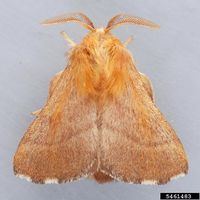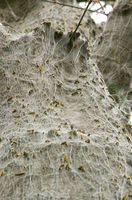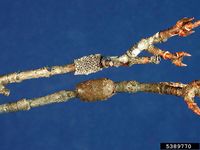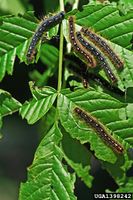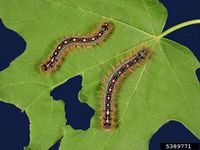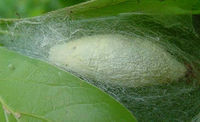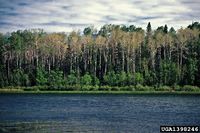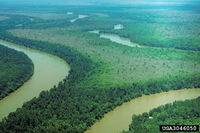Difference between revisions of "Malacosoma disstria"
From Pestinfo-Wiki
| Line 2: | Line 2: | ||
{{LiteratureDB|{{PAGENAME}}|browse,crops,benefialsN}} | {{LiteratureDB|{{PAGENAME}}|browse,crops,benefialsN}} | ||
[[File:Malacosoma_disstria_IPM1150089.jpg|250px|thumb|''Malacosoma disstria'' larvae with characteristic "footprint" pattern on their dorsal surface (click on image to enlarge it)<br/>Author(s): Herbert A. 'Joe' Pase III, Texas Forest Service<br/>Source: [http://www.ipmimages.org/browse/detail.cfm?imgnum=1150089 IPM Images]]] | [[File:Malacosoma_disstria_IPM1150089.jpg|250px|thumb|''Malacosoma disstria'' larvae with characteristic "footprint" pattern on their dorsal surface (click on image to enlarge it)<br/>Author(s): Herbert A. 'Joe' Pase III, Texas Forest Service<br/>Source: [http://www.ipmimages.org/browse/detail.cfm?imgnum=1150089 IPM Images]]] | ||
| − | <font color="#800000">'''''Malacosoma disstria'''''</font> (Hübner) - forest tent caterpillar<br/> | + | <font color="#800000">'''''Malacosoma disstria'''''</font> (Hübner, 1822) - (forest tent caterpillar)<br/> |
| − | attacks aspen and other trees in North America. The larvae don't produce a tent (but cover the tree trunk with silk webbing) and are characterized by the dorsal "keyhole" or "footprint" pattern. | + | attacks aspen and other trees in North America. Eggs are laid on the branches as egg bands in autumn. The larvae inside the eggs overwinter and emerge in spring around the time of budbreak. The gregarious larvae can cause extensive damage in outbreak years which may result in tree mortality. The larvae don't produce a tent (but cover the tree trunk with silk webbing) and are characterized by the dorsal "keyhole" or "footprint" pattern. |
For details see the respective page in [[wikipedia:Forest Tent Caterpillar Moth|Wikipedia]]. | For details see the respective page in [[wikipedia:Forest Tent Caterpillar Moth|Wikipedia]]. | ||
| Line 9: | Line 9: | ||
'''Synonyms:'''<br/> | '''Synonyms:'''<br/> | ||
''Clisiocampa disstria'' | ''Clisiocampa disstria'' | ||
| − | |||
{{VN | {{VN | ||
|en=forest tent caterpillar | |en=forest tent caterpillar | ||
| Line 16: | Line 15: | ||
<gallery widths=200px caption="Other images of Malacosoma disstria (IPM Images and Wikimedia Commons - click to enlarge)"> | <gallery widths=200px caption="Other images of Malacosoma disstria (IPM Images and Wikimedia Commons - click to enlarge)"> | ||
| − | File:Malacosoma_disstria_IPM5461483.jpg | + | File:Forest Tent Moth.JPG|adult |
| + | File:Malacosoma_disstria_IPM5461483.jpg|adult | ||
Forest tent caterpillar mat.jpg|webbing on tree trunk | Forest tent caterpillar mat.jpg|webbing on tree trunk | ||
File:Malacosoma_disstria_IPM5389770.jpg|egg masses on ''Acer saccharum'' (old on top, newly laid at bottom) | File:Malacosoma_disstria_IPM5389770.jpg|egg masses on ''Acer saccharum'' (old on top, newly laid at bottom) | ||
Revision as of 10:24, 4 August 2014
Taxonomic position
|
|---|
no parent categories |
| Literature database |
|---|
| 95 articles sorted by: |
| • year (recent ones first) |
| • research topics |
| • countries/regions |
| • host plants |
| • list of natural enemies |
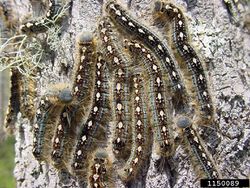
Malacosoma disstria larvae with characteristic "footprint" pattern on their dorsal surface (click on image to enlarge it)
Author(s): Herbert A. 'Joe' Pase III, Texas Forest Service
Source: IPM Images
Author(s): Herbert A. 'Joe' Pase III, Texas Forest Service
Source: IPM Images
Malacosoma disstria (Hübner, 1822) - (forest tent caterpillar)
attacks aspen and other trees in North America. Eggs are laid on the branches as egg bands in autumn. The larvae inside the eggs overwinter and emerge in spring around the time of budbreak. The gregarious larvae can cause extensive damage in outbreak years which may result in tree mortality. The larvae don't produce a tent (but cover the tree trunk with silk webbing) and are characterized by the dorsal "keyhole" or "footprint" pattern.
For details see the respective page in Wikipedia.
Synonyms:
Clisiocampa disstria
| Vernacular names | |
|---|---|
| • English: | forest tent caterpillar |
| • Français: | livrée de la forêt |
- Other images of Malacosoma disstria (IPM Images and Wikimedia Commons - click to enlarge)
